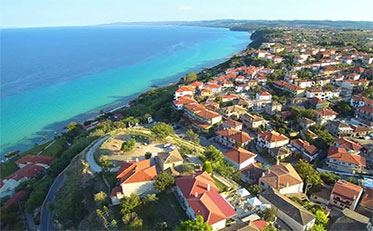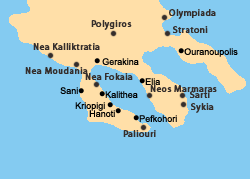|
Halkidiki Peninsula
Halkidiki belongs to Central Macedonia and its coastline forms four gulfs with a total length of 850 km. The rivers of the prefecture are very few and those that exist are torrents, since the distance between the mountains and the sea is very small. 50 per cent of the prefecture is covered by pine forests, oak and beech trees, especially to the east where most rainfalls are reported. Its Mediterranean climate is what makes Halkidiki one of the first prefectures in olive and citrus production, while its subsoil is rich in colored metals and minerals. Every town and village has quiet, picturesque coffee shops as well as cosmopolitan cafes which offer beverages and local sweets. Also, all kind of tavernas and restaurants are almost everywhere. The evening can begin with a movie at the cinemas of Moundania, Kassandria, Marmaras, Poligiros, Arnea and Ierissos. In the big towns, there are many clubs, bars and discos, satisfying everyone's taste. At Neos Marmaras, there are the cosmopolitan clubs where one can drink and dance to the latest hits, There are place with Greek music as well.
History Halkidiki is often mentioned in Greek mythology. It has been reported that the ancient name of Kassandra was Flegra, which means fireplace. It was the birthplace of the giants and it became a battlefield, when the giants tried to expel the gods from Mt Olympus. According to a myth, a giant, for the earthquakes of Engelados, was squashed under a piece of earth the gods threw at him and was buried under the Kassandra peninsula. But since the giants are immortal, occasionally he tried to free himself from the burden that squashed him and this is how earthquakes occur. Mount Athos was named after the giant Atho, who lifted and threw a whole mountain, as if it was a small stone, at the gods. Sithonia, according to mythology, has always been named after Sithonas, who was the son of Poseidon. He married the nymph Mende and they had a daughter, Pallene, after whom the Kassandra peninsula and one of its ancient cities were named. The mythical testimonies that followed came from the Trojan war period. Aeneas, leaving the ruined city of Troy, spent the winter near cape Karabournou, where he built a city which later took his name. It was at Kassandra that the Pellenians from Achaia also stopped on their way back from Troy. They had captivated Trojan women, who burnt down their ships, in order not to live in captivity. So the Pellenians were forced to live there and marry their slaves. It is believed that the peninsula took its second name from them. The first traces of life on Halkidiki appeared 700,000 years ago, according to the finds of the cave "Petralona". The first Greek emigrants arrived from Chalkida and Eretria during the Bronze Age, mainly for commercial purposes. In the beginning of the 5th century BC the Persians tried to occupy the area and the destruction of Mardonios's fleet is one of the most impressive historical events. Halkidiki raised several important literary figures, such as the great philosopher Aristoteles who is believed to have been born at Stagira in 384 BC. During the Peloponnesian war, hundreds of fights and retaliations occurred in the area, and since 348 BC, after the siege and destruction of Olinthos by Philip the 3rd, Halkidiki came under the Macedonian rule. It was conquered by the Romans, in 168 BC and during the Byzantine era suffered a number of invasions. The foundation of the first three monasteries of Agion Oros began in the 9th century and until the middle of the 14th century, most of Halkidiki was under the Serbian rule of Stephanos Dousan. The Turks occupied it soon afterwards, and soon it became one of the most important centres of the Othoman Empire, while Agion Oros was enjoying special privileges at the time, being completely autonomous. Halkidiki plays a leading part in the Greek Revolution of 1821, with the Serraian "Philiko" (of the Secret Society) Emmanuel Papas as a leader. The failure of the revolution in the area was followed by great slaughters and the extermination of its population. In 1822, Mechmet Passa invaded Halkidiki and slaughtered 200 monks causing new disasters. In 1854, Tsamis Karatasos landed on Sithonia and began attacking the Turks. He then fled to Agion Oros and from there to southern Greece. At the end of the 19th century the whole of Macedonia was in danger from the Bulgarian expansion. In October 1912, Greek rebels expelled the Turkish custodians and declared its union to Greece. After 1922, a new page in the history of Halkidiki was written, with the moving of thousands of refugees from Asia Minor and their settlement in the area
Place of interest CAVE OF PETRALONA OR KOKKINES PETRES The Cave of Petralona stands on the village of the same name at the foot of mount Katsika. It was studied in 1960 by research groups from the University of Thessaloniki. Research has shown that it was first inhabited 700,000 years ago. A very significant find is a female skull from 600,000 BC. The woman was about 25, which is, old for that period. It formed a new type of palaeanthrope, the Archanthrope, a transitional type between Homo Erectus and Homo Sapiens. Other findings include bones of hyenas, lions, deer and other animals. Of particular interest are also the stalagmites and stalactites of coral-like formations which are among exquisite multicolored pillars. Today, the cave is electrically lit and its chambers are decorated the way they were during the age of Archanthrope. Next to it, is a museum in which one can see findings of the cave and in whose entrance theatrical performances are held in summer. ANCIENT TORONI Ancient Toroni was one of the most significant towns of Halkidiki. After the Persian wars, it joined the Athenian League and was captured by the Spartans and the Athenians respectively during the Peloponnesian War. Many ruins of the ancient city were preserved up to the late 19th century, but they were destroyed so that their granite building material could be used for road surfacing in Thessaloniki and Constantinople. Today, only remains of ancient Toroni, south of the village, are still preserved. Traces of the big round tower in Anemomomylos as well as parts of the acropolis fortification walls on Vigla summit, also stand there. ANCIENT SETTLEMENTS OF NIKITI In the area of Nikiti, sites of big and small prehistoric settlements have been found. The most important of them was that of Galipsus where, in the 8th and 7th centuries BC, Chalkideans joined the local population. The founding of the present settlement began in the early 14th century. In 1300, when the area was dependent on Mount Athos, the independent village of Psallida, which is believed to have been destroyed in 1308 by the Catalans, lay there. Today, only its ruined tower still stands. ARCHAEOLOGICAL MUSEUM OF POLIGIROS Among the exhibits, there are findings from the city and the cemetery of Olinthos, as well as from the cemeteries of Ierissos, Toroni, Kastri and from other cities of Halkidiki. Some of the most important works one can admire in the museum are: The semi-finished Kouros, found at ancient Stagira. The "klazomeniaki" chest of Akanthos, decorated with painted images. The Stratoniou statues, excavated in Stratoni in 1960. One of them is a female, the "Despoina of Stratonio" (Lady of Stratoni), and the other one a male. There are also various vessels from Pirgadikia, typical examples of the production of an unknown pottery workshop from the 4th century BC, and many other exhibits. CATHEDRAL AT KASSANDRIA The Cathedral, constructed in 1850, is dedicated to the Birth of the Virgin (Gennissi tis Theoto-kou). The western entrance of the Church is decorated with a sculpted arch above the door dating back to the Late Christian period, which has reliefs and is considered to have come from the first screen of the Church of Agios Dimitrios in Thessaloniki. Another similar arch, coming from the same Church, lies in the Byzantine Museum in Athens. FOLKLORE MUSEUM OF AFITOS The museum includes exhibits of traditional folk art, vessels, ceramics, embroidery, woven fabrics, and tools used by the people of the area in their everyday life.
METOCHIOU FORTRESS OF ZOGRAFOU MONASTERY The village was built around the establishments of "metochi" (property belonging to a religious institution) of Zografou Monastery at Agion Oros, and was named after it. Today, what has been saved from "metochi" is the Byzantine fortress which is a construction of the 14th century, as well as the church, founded in 1842, and other subsidiary buildings from the 19th century. PROSFORIOU FORTRESS AT OURANOUPOLI Prosforiou is the biggest fortress on Halkidiki and the best preserved of its kind. Its construction is estimated to have been before 1344, and it is considered one of the best examples of monastery architecture. The purpose of its construction was for the protection of "metochi", of Vatopediou Monastery, and till the middle of the previous century, it had been preserved intact. Its upper floor was destroyed in 1850 and then the roof was constructed, as it appears today, under which there is a chapel dedicated to St Constantinos and St Eleni. MONASTERY OF AGIA ANASTASIA FARMAKOLYTRIA The monastery is said to have been founded by Leon the 6th in the 19th century, but this has not been cross-checked. In all probability, it was built in 1522 by St Theonas, who later became metropolitan bishop of Thessaloniki. During the Turkish domination, the monastery owned many acres of land but it was destroyed by the Turks during the Greek War of Independence of 1821 and was rebuilt from scratch in 1830. Today, it belongs to the Ecumenical Patriarchate of Constantinople and honors St Anastasia on the 22nd of December. AGIASMA APOSTOLOU PAVLOU On the eastern side of Nea Fokea lies Agiasma Apostolou Pavlou. It is an underground corridor of about 20 km in length, which has been carved on the natural rock and ends in a rectangular underground chamber. It is probably an ancient burial construction that, during the Byzantine period, was rearranged into a church. The chamber's walls had been painted during some period of time, but a large part of these paintings was destroyed by humidity. Tradition says that the Apostle Paul was teaching at Ierissos at the time when haunted, and with his life in danger, he went into a hole of the earth. Then, passing through an underground corridor, he arrived at Kassandra and came out at the chamber of the "agiasma".
Transportation By Air There are regular 50 minute flights from Athens to Thessaloniki (Salonica). By buses There is daily service from Thessaloniki with KTEL buses to Nea Moudania, Poligiros, the villages of Kassandria and Sithonia, Ierissos, and Ouranoupoli.
|




